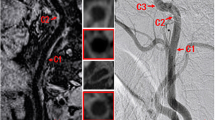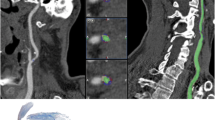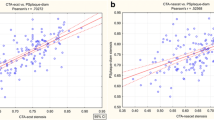Abstract
Our purpose was to assess the reproducibility of and differences between the most commonly used methods for assessing carotid artery stenosis using magnetic resonance angiography (MRA). We studied 55 patients who underwent axial three-dimensional time-of-flight MRA (1.5 T). Quantitative caliper measurements were performed from maximum intensity projection (MIP) and multiple planar reconstruction (MPR) images, according to the criteria of the North American Symptomatic Carotid Endarterectomy Trial (NASCET) and European Carotid Surgery Trial (ECST). The measurements were compared to each other and to visual interpretation, using conventional angiography as the reference. The measured percentage stenoses were higher on MRA than on digital subtraction angiography (DSA) using both NASCET (mean difference 1.9–3.0%) and ECST (6.3–6.7%) criteria. The kappa coefficients for the agreement between DSA and MRA were higher using the NAS-CET (0.61–0.76) than the ECST criteria (0.52–0.65). No statistically significant differences were found between measurements from MIP and MPR images. The ECST measurement criteria gave significantly higher percentage stenoses than the NASCET criteria (P<0.001), this difference being more prominent on MRA (mean difference in diameter stenosis percentage 14.3–16.4%) than on DSA (7.6–11.2%) and most important with mild stenoses. The difference between visual interpretation and quantitative measurements on MRA was significant (P=0.01–0.001). There were no statistically significant interobserver differences in the MRA film readings, either in visually estimated degrees of stenosis or stenosis measurements. Thus, the different criteria of the two multicentre trials led to significantly different results, especially in the assessment of mild stenosis, and these differences are more important with MRA than with aging modalities or the reconstruction programs seem less important.
Similar content being viewed by others
References
North American Symptomatic Carotid Endarterectomy Trial Collaborators (1991) Beneficial effect of carotid endarterectomy in symptomatic patients with high grade carotid stenosis. N Engl J Med 325: 445–453
European Carotid Surgery Trialists' Collaborative Group (1991) MRC European carotid surgery trial: interim results for symptomatic patients with severe (70–99%) or with mild (0–29%) carotid stenosis. Lancet 337: 1235–1243
Masaryk AM, Ross JS, DiCello MC, Modic MT, Paranandi L, Masaryk TJ (1991) 3DFT MR angiography of the carotid bifurcation: potential and limitations as a screening examination. Radiology 179: 797–804
Heiserman JE, Drayer BP, Fram EK, Keller PJ, Bird CR, Hodak JA, Flom RA (1992) Carotid artery stenosis: clinical efficacy of two-dimensional time-of-flight MR angiography. Radiology 182: 761–768
Kido DK, Panzer RJ, Szumowski J, Hollander J, Ketonen LM, Monajati A, Ouriel K, Manzione JV, Dumoulin CL, Souza SP, Katz JL, Rothenberg BM (1991) Clinical evaluation of stenosis of the carotid bifurcation with magnetic resonance angiographic techniques. Arch Neurol 48: 484–489
Huston J, Lewis BD, Wiebers DO, Meyer FB, Riederer SJ, Weaver AL (1993) Carotid artery: prospective blinded comparison of two-dimensional time-of-flight MR angiography with conventional angiography and duplex US. Radiology 186: 339–344
Laster RE, Acker JD, Halford HH III, Nauert TC (1993) Assessment of MR angiography versus arteriography for evaluation of cervical carotid bifurcation disease. AJNR 14:681–688
Blatter DD, Bahr AL, Parker DL, Robison RO, Kimball JA, Perry DM, Horn S (1993) Cervical carotid MR angiography with multiple overlapping thin-slab acquisition: comparison with conventional angiography. AJR 161: 1269–1277
Anderson CM, Saloner D, Lee RE, Griswold VJ, Shapeero LG, Rapp JH, Nagarkar S, Pan X, Gooding GAW (1992) Assessment of carotid artery stenosis by MR angiography: comparison with X-ray angiography and color-coded Doppler ultrasound. AJNR 13: 989–1003
Polak JF, Kalina P, Donaldson MC, O'Leary DH, Whittemore AD, Mannick JA (1993) Carotid endarterectomy: preoperative evaluation of candidates with combined Doppler sonography and MR angiography. Radiology 186: 333–338
Fox AJ (1993) How to measure carotid stenosis. Radiology 186: 316–318
Hankey GJ, Warlow CP (1990) Symptomatic carotid ischaemic events: safest and most cost effective way of selecting patients for angiography, before carotid endarterectomy. BMJ 300: 1485–1491
Fleiss JL (1981) Statistical methods for rates and proportions, 2nd edn Wiley New York, p 212
Markus JB, Somers S, Franic SE, Moola C, Stavenson GW (1989) Interobserver variation in the interpretation of abdominal radiographs. Radiology 171: 69–71
Pan XM, Anderson CM, Reilly LM, Saloner D, Lee RE, Perez S, Krupski WC, Rapp JH (1992) Magnetic resonance angiography of the carotid artery combining two- and three-dimensional acquisitions. J Vasc Surg 16: 609–618
Litt AW, Eidelman EM, Pinto RS, Riles TS, McLachlan SJ, Schwartzenberg ST, Weinreb JC, Kricheff II (1991) Diagnosis of carotid artery stenosis: comparison of 2DFT time-of-flight MR angiography with contrast angiography in 50 patients. AJNR 12: 149–154
Pavone P, Marcili L, Catalano C, Petroni GA, Aytan E, Cardone GP, Passariello R (1992) Carotid arteries: evaluation with low-field-strength MR angiography. Radiology 184: 401–404
Wesbey GE, Bergan JJ, Moreland SI, Sedwitz MM, Bardin JA, Schmalbrock P, Listerud J (1992) Cerebrovascular magnetic resonance angiography: A critical verification. J Vasc Surg 16: 618–632
Sitzer M, Fürst G, Fischer H, Siebler M, Fehlings T, Kleinschmidt A, Kahn T, Steinmetz H (1993) Between-method correlation in quantifying internal carotid stenosis. Stroke 24: 1513–1518
The Amaurosis Fugax Study Group (1990) Current management of amaurosis fugax. Stroke 21: 201–208
Chong WK, Raphael MJ (1992) The significance of haemodynamic significance. II. Specific arteries. J Intervent Radiol 7: 55–63
Vanninen R, Manninen H, Koivisto K, Tulla H, Partanen K, Puranen M (1994) Carotid stenosis by digital subtraction angiography: reproducibility of the ECST and NASCET measurement methods and visual interpretation. AJNR 15: 1635–1641
Author information
Authors and Affiliations
Rights and permissions
About this article
Cite this article
Vanninen, R.L., Manninen, H.I., Partanen, P.K. et al. How should we estimate carotid stenosis using magnetic resonance angiography?. Neuroradiology 38, 299–305 (1996). https://doi.org/10.1007/BF00596574
Received:
Accepted:
Issue Date:
DOI: https://doi.org/10.1007/BF00596574




